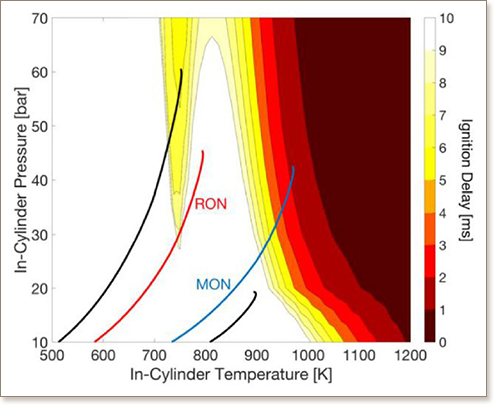Autoignition of isooctane beyond RON and MON conditions


The present study experimentally examines the low temperature autoignition area of isooctane within the in-cylinder pressure - in-cylinder temperature map. Experiments were run with the help of a CFR engine. The boundaries of this engine were extended so that experiments could be performed outside the domain delimited by RON and MON traces. Since HCCI combustion is governed by kinetics, the rotation speed for all the experiments was set at 600 rpm to allow time for low temperature heat release (LTHR). All the other parameters (intake pressure, intake temperature, compression ratio and equivalence ratio), were scanned, such as the occurrence of isooctane combustion. The principal results showed that LTHR for isooctane occurs effortlessly under high intake pressure (1.3 bar) and low intake temperature (25 °C). Increasing the intake temperature leads to the loss of the LTHR, and therefore to a smaller domain on the pressure-temperature trace. In such a case, the LTHR domain is restricted from 20 to 50 bar in pressure and from 600 to 850 K in temperature. By slightly decreasing the intake pressure, the LTHR domain remains unchanged, but the LTHR tends to disappear, and finally, at 1.0 bar, the LTHR domain ceases to exist. When the equivalence ratio is moved from 0.3 to 0.4, the LTHR domain is delimited in the same range of pressure and temperature, but the start of combustion occurs slightly earlier for the same pressure-temperature trace. Similar conclusions were drawn regarding the variation of both intake pressure and temperature, except that few LTHR points were observed under 1.0 bar intake.
DOI: 10.4271/2018-01-1254

"KAUST shall be a beacon for peace, hope and reconciliation, and shall serve the people of the Kingdom and the world."
King Abdullah bin Abdulaziz Al Saud, 1924 – 2015
Thuwal 23955-6900, Kingdom of Saudi Arabia
© King Abdullah University of Science and Technology. All rights reserved